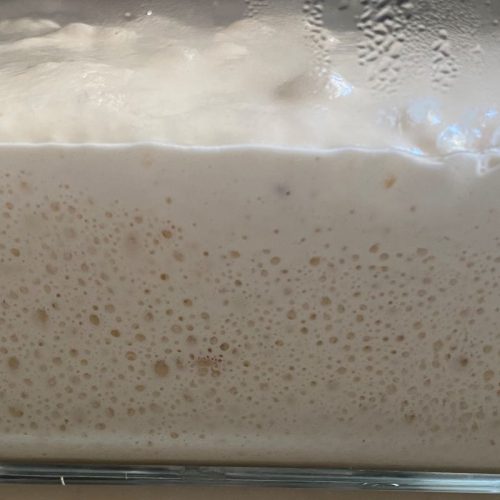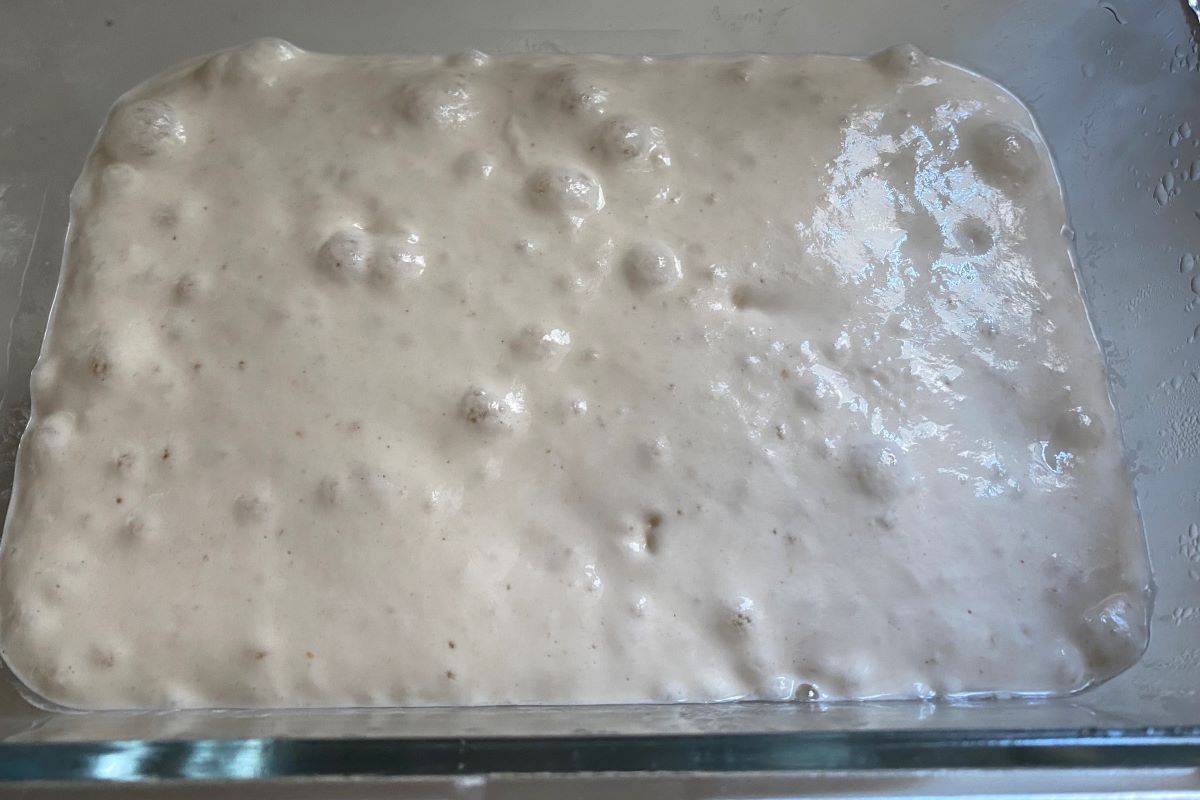Sourdough barm for high hydration breads is the basic mother starter or ‘chef’ used by high hydration sourdough bakers. The hydration refers to the weight amount of water to flour in the dough. High hydration covers the range above 80%.Here we teach how to activate the yeasts and bacteria that naturally occur in flour. Thereafter they are working for you in raising and flavoring your breads. You should store your barm in the refrigerator. Refresh it every 3 days, to keep it healthy and active. We prefer to use a poolish (very wet) barm. In sourdough bread recipes listed in wilfriedscooking.com, we use this barm, the development of which is described here.
The art of making sourdough barm
Yeasts and bacteria
Flour contains natural yeasts and bacteria, which have been able to survive the dry conditions. Think of similarities to dried yeast. Barm allows both yeast development, but also bacterial and enzymatic reactions taking place. In the latter the by-product is lactic acid (mildly sour) or even acetic acid (more sour). In general, the barm will make more sour breads when more time of the fermentation process is done at very cool temperatures. Usually after the bulk fermentation has taken place at room temperature.
Also when making a starter from barm first, the ratio of new flour to barm is important. The more you dilute the barm the less acid your bread will become. You can imagine that people in colder climates with kitchens around 14 C, may take longer to do the bulk fermentation. Consequently, their breads will become more acid. In hotter climates, like in Hong Kong, I really need to keep kitchen fermentation short and create acidity in the fridge.
How to develop a seed culture and a barm
For the seed culture I usually start with rye flour first. Thereafter I dilute this mixture gradually with (wheat) bread flour. Your seed culture is usually done in five days and your barm will be ready for the first time latest on day 6.
When ready, please bear in mind to regularly refresh the barm. Also realize that the yeasty fermentation goes a lot faster than the bacterial reactions generating acid. The colder temperatures will slow down the yeast fermentation in favor of the bacteria and the acidic taste.
Special equipment
- a container or bowl where the dough can rise
- plastic foil to cover

Sourdough barm
Ingredients
Ingredients to make the initial seed culture
- 1/2 cup whole rye flour you may mix in some very coarsely ground rye kernels
- 2 cups unbleached bread flour
- 1.37 cups water free of chlorine
Ingredients to make the barm
- 1.75 cup unbleached bread flour
- 1/2 cup of the end seed culture (see above)
- 1 cup water free of chlorine
Ingredients to re-fresh the barm
- oz barm
- oz unbleached bread flour
- oz water free of chlorine
Instructions
Making the seed culture
- On day one, mix 1/2 cup whole rye flour with 3/8 cup of water (roughly 45% in weight more water than flour. Mix well. Place this dough in a glass or plastic beaker and cover. Place at ambient temperature on the counter out of direct sun light.
- On day two, we mix 1/2 cup bread flour and a 1/4 cup water, separately until all is mixed well. We add this mixture to the day one mixture and cover again. The smell can be obnoxious, but please ignore that
- On day three you may have noticed some fermentation. Regardless, discard half of the mixture of day 2 and mix it with a fresh mixture of 1/2 cup bread flour and 1/4 cup water. Cover again and let stand at room temperature
- On day 4 you will have noticed fermentation. if the dough has not expanded double the size, wait for that to happen. Otherwise do as the previous day and discard half of the day 3 mixture and mix it again with 1/2 cup of bread flour and 1/4 cup of water. Wait until the dough has at the least doubled in size. This could be 4-24 h. At that moment your seed mixture is ready to make the barm from
Making the barm
- Mix 1/2 cup of seed mixture with 1 cup of water and 1.75 cup of bread flour. This means the water and the newly added flour are in equal proportion by weight
- Place it is a large enough container as the fermentation may be very lively. It may take 4-6 h before the fermentation has peaked (when it shows very bubbly)
- At that point place it in the refrigerator overnight before using. This will impair some acidity to the barm. The next morning (day 6) your barm is ready and you can start baking bread
Refreshing the barm
- Your barm will remain potent when stored in the fridge for 3 days. After that you need to refresh
- You have a choice: either double the barm (at the least) or quadruple the barm. When doubling, the barm will remain more acidic, when quadrupling the barm will become less acidic. Also an older barm of 3 days will be more acidic then a one day old barm
- To refresh the barm, add equal weight amounts of water and bread flour to the to-be-refreshed barm and let ferment at room temperature. Usually after 4-8 hr the volume hads tripled and the refreshed barm can be refrigerated and used again in a time span of 3 days.
Remarks
- If the very strong (high gluten) bread flour is not available, you can use all purpose flour.
- You can also make a barm using partially rye or whole wheat flour. However, usually a starter for a bread can better incorporate other types of flour
- A good example of a high hydration sourdough bread can be found here.



